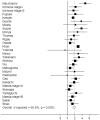Blood vessel invasion as a strong independent prognostic indicator in non-small cell lung cancer: a systematic review and meta-analysis
- PMID: 22194927
- PMCID: PMC3237541
- DOI: 10.1371/journal.pone.0028844
Blood vessel invasion as a strong independent prognostic indicator in non-small cell lung cancer: a systematic review and meta-analysis
Abstract
Background and objective: Blood vessel invasion plays a very important role in the progression and metastasis of cancer. However, blood vessel invasion as a prognostic factor for survival in non-small cell lung cancer (NSCLC) remains controversial. The aim of this study is to explore the relationship between blood vessel invasion and outcome in patients with NSCLC using meta-analysis.
Methods: A meta-analysis of published studies was conducted to investigate the effects of blood vessel invasion on both relapse-free survival (RFS) and overall survival (OS) for patients with NSCLC. Hazard ratios (HRs) with 95% confidence intervals (95% CIs) were used to assess the strength of this association.
Results: A total of 16,535 patients from 52 eligible studies were included in the systematic review and meta-analysis. In total, blood vessel invasion was detected in 29.8% (median; range from 6.2% to 77.0%) of patients with NSCLC. The univariate and multivariate estimates for RFS were 3.28 (95% CI: 2.14-5.05; P<0.0001) and 3.98 (95% CI: 2.24-7.06; P<0.0001), respectively. For the analyses of blood vessel invasion and OS, the pooled HR estimate was 2.22 (95% CI: 1.93-2.56; P<0.0001) by univariate analysis and 1.90 (95% CI: 1.65-2.19; P<0.0001) by multivariate analysis. Furthermore, in stage I NSCLC patients, the meta-risk for recurrence (HR = 6.93, 95% CI: 4.23-11.37, P<0.0001) and death (HR = 2.15, 95% CI: 1.68-2.75; P<0.0001) remained highly significant by multivariate analysis.
Conclusions: This study shows that blood vessel invasion appears to be an independent negative prognosticator in surgically managed NSCLC. However, adequately designed large prospective studies and investigations are warranted to confirm the present findings.
Conflict of interest statement
Figures



Similar articles
-
Impact of residual disease as a prognostic factor for survival in women with advanced epithelial ovarian cancer after primary surgery.Cochrane Database Syst Rev. 2022 Sep 26;9(9):CD015048. doi: 10.1002/14651858.CD015048.pub2. Cochrane Database Syst Rev. 2022. PMID: 36161421 Free PMC article.
-
Lymphovascular invasion as a prognostic indicator in stage I non-small cell lung cancer: a systematic review and meta-analysis.Ann Thorac Surg. 2014 Mar;97(3):965-71. doi: 10.1016/j.athoracsur.2013.11.002. Epub 2014 Jan 11. Ann Thorac Surg. 2014. PMID: 24424014
-
Immunotherapy (excluding checkpoint inhibitors) for stage I to III non-small cell lung cancer treated with surgery or radiotherapy with curative intent.Cochrane Database Syst Rev. 2017 Dec 16;12(12):CD011300. doi: 10.1002/14651858.CD011300.pub2. Cochrane Database Syst Rev. 2017. Update in: Cochrane Database Syst Rev. 2021 Dec 6;12:CD011300. doi: 10.1002/14651858.CD011300.pub3. PMID: 29247502 Free PMC article. Updated.
-
Cost-effectiveness of using prognostic information to select women with breast cancer for adjuvant systemic therapy.Health Technol Assess. 2006 Sep;10(34):iii-iv, ix-xi, 1-204. doi: 10.3310/hta10340. Health Technol Assess. 2006. PMID: 16959170
-
Targeted therapy for advanced anaplastic lymphoma kinase (<I>ALK</I>)-rearranged non-small cell lung cancer.Cochrane Database Syst Rev. 2022 Jan 7;1(1):CD013453. doi: 10.1002/14651858.CD013453.pub2. Cochrane Database Syst Rev. 2022. PMID: 34994987 Free PMC article.
Cited by
-
Impact of microvascular invasion on 5-year overall survival of resected non-small cell lung cancer.J Bras Pneumol. 2022 Jul 8;48(3):e20210283. doi: 10.36416/1806-3756/e20210283. eCollection 2022. J Bras Pneumol. 2022. PMID: 35830051 Free PMC article.
-
Cytochrome P450 2A6 deletion polymorphism and risk of lung cancer: a meta-analysis.Mol Biol Rep. 2013 Sep;40(9):5255-9. doi: 10.1007/s11033-013-2625-0. Epub 2013 Jun 4. Mol Biol Rep. 2013. PMID: 23733493
-
Clinical Significance of Lymphatic Infiltration Detected by Immunohistochemical Double Staining in Patients with Endometrial Cancer.Clin Med Insights Oncol. 2023 Feb 1;17:11795549231152308. doi: 10.1177/11795549231152308. eCollection 2023. Clin Med Insights Oncol. 2023. PMID: 36744170 Free PMC article.
-
Lipid biomarkers that reflect postoperative recurrence risk in lung cancer patients who smoke: a case-control study.Lipids Health Dis. 2023 Jan 28;22(1):15. doi: 10.1186/s12944-023-01778-3. Lipids Health Dis. 2023. PMID: 36707819 Free PMC article.
-
Clinical significance and role of lymphatic vessel invasion as a major prognostic implication in non-small cell lung cancer: a meta-analysis.PLoS One. 2012;7(12):e52704. doi: 10.1371/journal.pone.0052704. Epub 2012 Dec 20. PLoS One. 2012. PMID: 23285161 Free PMC article.
References
-
- Jemal A, Bray F, Center MM, Ferlay J, Ward E, et al. CA Cancer J Clin. 2011;61:69–90. - PubMed
-
- Chansky K, Sculier JP, Crowley JJ, Giroux D, Van Meerbeeck J, et al. The International Association for the Study of Lung Cancer Staging Project: prognostic factors and pathologic TNM stage in surgically managed non-small cell lung cancer. J Thorac Oncol. 2009;4:792–801. - PubMed
-
- Steels E, Paesmans M, Berghmans T, Branle F, Lemaitre F, et al. Role of p53 as a prognostic factor for survival in lung cancer: a systematic review of the literature with a meta-analysis. Eur Respir J. 2001;18:705–719. - PubMed
-
- Meert AP, Martin B, Delmotte P, Berghmans T, Lafitte JJ, et al. The role of EGF-R expression on patient survival in lung cancer: a systematic review with meta-analysis. Eur Respir J. 2002;20:975–981. - PubMed
Publication types
MeSH terms
LinkOut - more resources
Full Text Sources
Other Literature Sources
Medical

